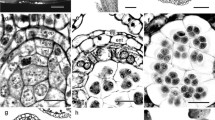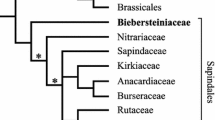Abstract
Cardiopteris (Cardiopteridaceae), a twining herb of two or three species distributed from Southeast Asia to Northern Australia, requires an embryological study for better understanding of its reproductive features. The present study of C. quinqueloba showed that the ovule and seed development involves a number of unusual structures, most of which are unknown elsewhere in angiosperms. The ovule pendant from the apical placenta is straight (not orthotropous), ategmic, and tenuinucellate, developing a monosporic seven-celled/eight-nucleate female gametophyte with an egg apparatus on the funicular side. Fertilization occurs by a pollen tube entering from the funicular side, resulting in a zygote on the funicular side. The endosperm is formed by the cell on the funicular side in the two endosperm cell stage. While retaining a (pro)embryo/endosperm as it is, the raphe (differentiating late in pre-fertilization stages) elongates toward the antiraphal side during post-fertilization stages, resulting in an anatropous seed. The two-cell-layered nucellar epidermis (belatedly forming by periclinal divisions), along with the raphe, envelops the embryo/endosperm entirely as the seed coat. The possibility was discussed that the arrested integument development triggers a series of the subsequent unusual structures of ovule and seed development. The fertilization mode in Cardiopteris underpins the hypothesis that the Polygonum‒type female gametophyte comprises two four-celled archegonia.







Similar content being viewed by others
References
Angiosperm Phylogeny Group (2003) An update of the Angiosperm Phylogeny Group classification for the orders and families of flowering plants: APG II. Bot J Linn Soc 141:399–436
Angiosperm Phylogeny Group (2009) An update of the Angiosperm Phylogeny Group classification for the orders and families of flowering plants: APGIII. Bot J Linn Soc 161:105–121
Ao C, Tobe H (2015) Floral morphology and embryology of Helwingia (Helwingiaceae, Aquifoliales): systematic and evolutionary implications. J Plant Res 128:161–175
Bentham G, Hooker JD (1862‒1867) Genera plantarum, vol 9. Reeve Co., London
Blume CL (1847) De genere Cardiopteri. Rumphia 3:205–207
Bouman F (1984) The ovule. In: Johri BM (ed) Embryology of angiosperms. Springer, Berlin, pp 123–157
Brewbaker JL (1967) The distribution and phylogenetic significance of binucleate and trinucleate pollen grains in angiosperms. Am J Bot 54:1069–1083
Chamberlain CJ (1935) Gymnosperms: structure and evolution. The University of Chicago Press, Chicago
Copeland HF (1963) Structural notes on hollies (Ilex aquifolium and I. cornuta, family Aquifoliaceae). Phytomorphology 13:455–464
Corner EJH (1976) The seeds of dicotyledons, vols 1, 2. Cambridge University Press, Cambridge
Cronquist S (1981) An integrated system of classification of flowering plants. Columbia University Press, New York
Davis GL (1966) Systematic embryology of flowering plants. Wiley, New York
Doweld AB (2000) Cardiopteridaceae. In: Takhtajan A (ed) Comparative seed anatomy, vol 6. Nauka, St. Petersburg, pp 120–121 (in Russian)
Engler A (1897) Icacinaceae. In: Engler A, Prantl K (eds) Die natürlichen Pflanzenfamilien, Teil 3(5). Wilhelm Engelmann, Leipzig, pp 233–257
Fagerlind F (1945) Bau des Gynöceums, der Samenanlage und des Embryosackes bei einigen Repräsentanten der Familie Icacinaceae. Svensk Bot Tidskr 39:346–364
Friedman WE, Williams JH (2003) Modularity of the angiosperm female gametophyte and its bearing on the early revolution of endosperm in flowering plants. Evolution 57:216–230
Herr JM Jr (1959) The development of the ovule and the megagametophyte in the genus Ilex. J Elisha Mitchell Sci Soc 75:107–128
Herr JM Jr (1961) Endosperm development and associated ovule modifications in the genus Ilex. J Elisha Mitchell Sci Soc 77:26–32
Hutchinson J (1973) The Families of flowering plants, 3rd edn. Oxford University Press, Oxford
Jackson BD (1928) A glossary of botanic terms, 4th edn. Duckworth, London
Kårehed J (2001) Multiple origin of the tropical forest tree family Icacinaceae. Am J Bot 88:2259–2274
Kong D-R, Peng H, Liang H-X (2002) A new type of embryo sac in Cardiopteris and its systematic implications. Acta Bot Sin 44:496–498
Kong DR, Schori M, Lu SG, Li L, Peng H (2014) Floral development of Cardiopteris, with emphasis on gynoecial structure and ovular morphology. J Syst Evol 52:629–642
Mabberley DJ (2008) Mabberley’s plant book. A portable dictionary of plants, their classification and uses. Cambridge University Press, New York
Mauritzon J (1936) Embryologische Angaben über Stackhousiaceae, Hippocrateaceae und Icacinaceae. Svensk Bot Tidskr 30:541–550
Ohnishi T, Takanashi H, Mogi M, Takahashi H, Kikuchi S, Yano K, Okamoto T, Fujita M, Kurata N, Tsutsumi N (2011) Distinct gene expression profiles in egg and synergid cells of rice as revealed by cell type-specific microarrays. Plant Physiol 155:881–891
Padmanabhan D (1961) A contribution to the embryology of Gomphandra polymorpha. Proc Natl Inst Sci India B 27:389–398
Porsch O (1907) Versuch einer phylogenetischen Erkärung des Embryosackes und der doppelten Befruchtung der Angiospermen. Gustav Fischer, Jena
Reveal JL (2012) An outline of a classification scheme for extant flowering plants. Phytoneuron 37:1–221
Scholz H (1964) Celastrales. In: Melchior H (ed) A Engler’s Syllabus der Pflanzenfamilien. II. Gebrüder Borntraeger, Berlin, pp 289–300
Schori M, Furness CA (2014) Pollen diversity in Aquifoliales. Bot J Linn Soc 175:169–190
Schürhoff PN (1921) Die Entwicklungsgeschichte von Ilex aquifolium. Ber Dtsch Bot Ges 39:377–379
Sleumer H (1942) Peripterygiaceae. In: Engler A, Prantl K (eds) Die Natürlichen Pflanzenfamilien, 20b. Duncker & Humblot, Berlin, pp 397–400
Sleumer H (1971) Cardiopteridaceae. In: van Steenis CGGJ (ed) Flora Malesiana, vol 7. Noordhoff International Publishing, Leyden, pp 93–96
Sogo A, Tobe H (2005) Intermittent pollen-tube growth in pistils of alders (Alnus). Proc Natl Acad Sci USA 102:8770–8775
Sogo A, Noguchi J, Jaffré T, Tobe H (2004) Pollen-tube growth pattern and chalazogamy in Casuarina equisetifolia (Casuarinaceae). J Plant Res 117:37–46
Soltis DE, Smith SA, Cellinese N, Wurdack KJ, Tank DC, Brockington SF, Refulio-Rodriguez NF, Walker JB, Moore MJ, Carlsward BS, Bell CD, Matvis M, Crawley S, Black C, Diouf D, Xi Z, Rushworth CA, Gitzendanner MA, Sytsma KJ, Qiu Y-L, Hilu KW, Davis CC, Sanderson MJ, Beaman RS, Olmstead RG, Judd WS, Donoghue MJ, Soltis PS (2011) Angiosperm phylogeny: 17 genes, 640 taxa. Am J Bot 98:704–730
Stevens PF (2001 onwards) Angiosperm phylogeny Website. Version 12, July 2012. http://www.mobot.org/MOBOT/research/APweb/. Accessed 27 Feb 2015
Takhtajan A (1997) Diversity and classification of flowering plants. Columbia University Press, New York
Takhtajan A (2009) Flowering plants, 2nd edn. Springer, New York
Tank DC, Donoghue MJ (2010) Phylogeny and phylogenetic nomenclature of the Campanulidae based on an expanded sample of genes and taxa. Syst Bot 35:425–441
The Plant List (2013) Version 1.1. Published on the Internet; http://www.theplantlist.org/. Accessed 1st Jan
Thorne RF (1992) Classification and geography of the flowering plants. Bot Rev (Lancaster) 58:225–348
Tobe H (2012) Floral morphology and structure of Cardiopteris (Cardiopteridaceae) with special reference emphasis on the gynoecium: systematic and evolutionary implications. J Plant Res 125:361–369
Tobe H (2015) Embryology of Phyllonoma (Phyllonomaceae, Aquifoliales): characteristics and character evolution. J Plant Res 128:633–642
Tobe H, Kimoto Y, Prakash N (2007) Development of the female gametophyte in Austrobaileya scandens (Austrobaileyaceae). J Plant Res 120:431–436
van Tieghem P (1898) Structure de quelques ovules et patti qu’on en pent tirer am liorer la classification. J Bot (Morot) 12:197–220
Williams JH, Friedman WE (2004) The four-celled female gametophyte of Illicium (Illiciaceae; Austrobaileyales): implications for understanding the origin and early evolution of monocots, eumagnoliids, and eudicots. Am J Bot 91:332–351
Acknowledgments
I dedicate this article to the late James F. Maxwell, who collected the materials used in the present study. I am grateful to Tomoki Kadokawa and Takenori Yamamoto for their assistance in preparing some figures used in the present article, and to Tomoko Fukuda for translating a Russian article into English. The study was supported by a Grant-in-Aid for Scientific Research from the Japan Society for the Promotion of Science (No. 25440208).
Author information
Authors and Affiliations
Corresponding author
Electronic supplementary material
Below is the link to the electronic supplementary material.
Rights and permissions
About this article
Cite this article
Tobe, H. Embryology of Cardiopteris (Cardiopteridaceae, Aquifoliales), with emphasis on unusual ovule and seed development. J Plant Res 129, 883–897 (2016). https://doi.org/10.1007/s10265-016-0845-9
Received:
Accepted:
Published:
Issue Date:
DOI: https://doi.org/10.1007/s10265-016-0845-9




